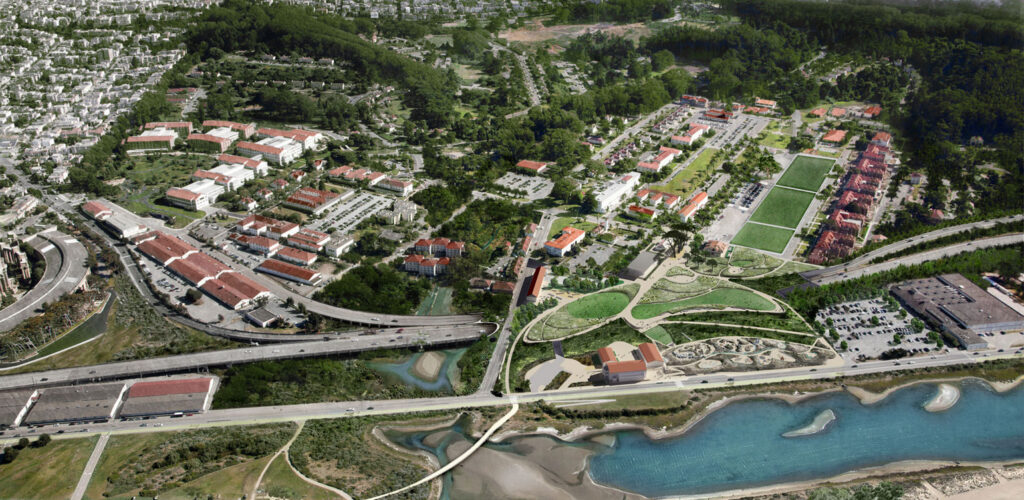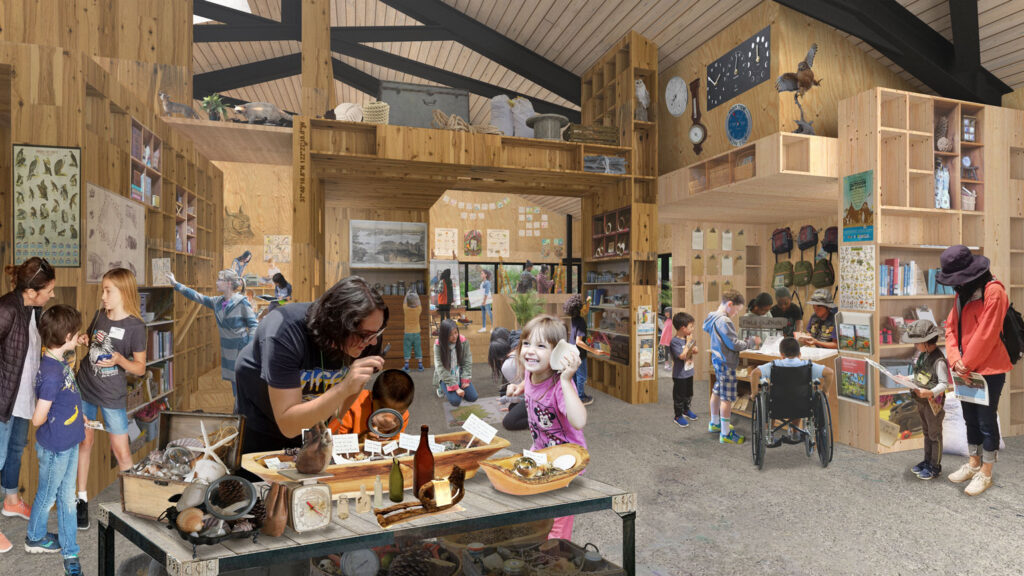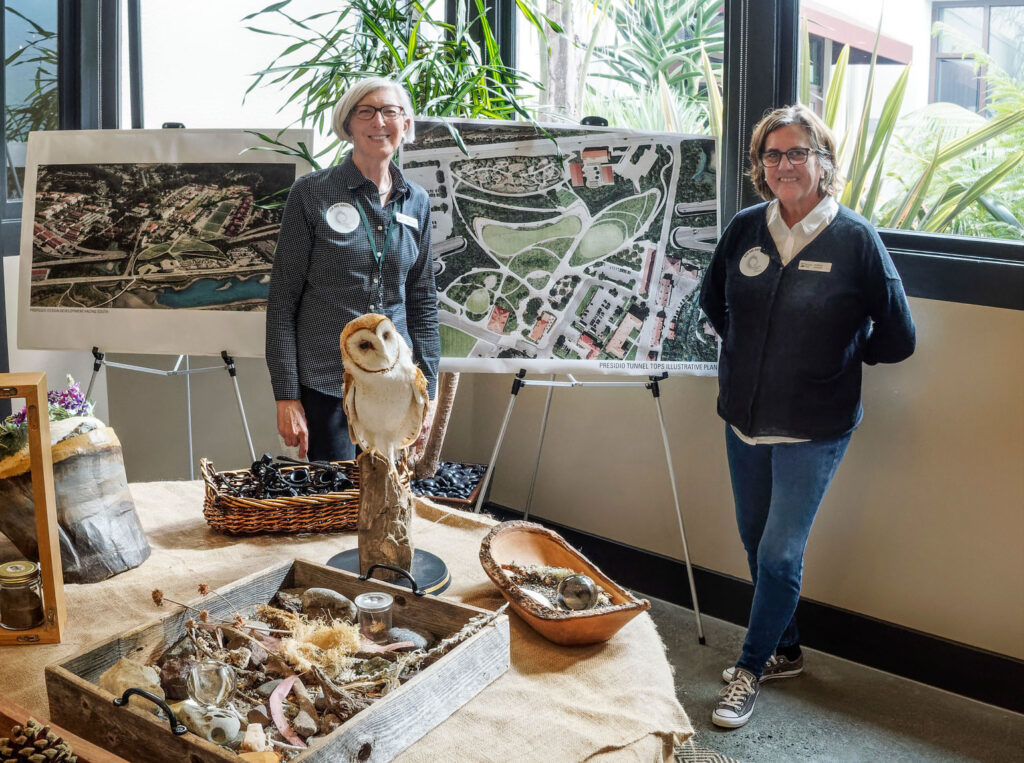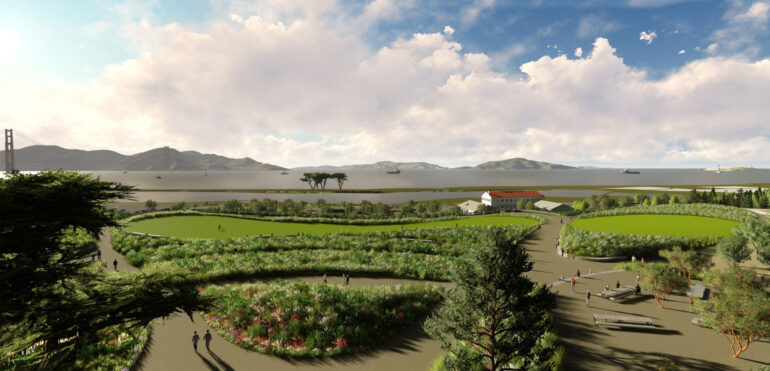Women have long been instrumental to the Bay Area’s green spaces. There was Caroline Sealy Livermore and Sepha Evers, the women behind the Marin Conservation League, who were responsible for saving Angel Island in the 1930s. In the 1970s, Amy Meyer fought for the Golden Gate National Recreation Area, which today includes many of Marin’s wild areas, and most of San Francisco’s most significant green spaces, including the Presidio.
The Presidio has had a long journey from its origins as a fishing ground for the native Ohlone. It was first built up as a military fort for the Spanish in 1776, then became a Mexican garrison and finally was taken over by the U.S. army in 1846. The military left in 1994, and over the years this scenic area was transformed and returned to nature, first with the addition of Crissy Field and its trails and bikeways and the reclaiming of areas such as the Main Parade Ground, and then with the restoration of the tidal marshland area, where thousands of native plants have been replanted and helped to encourage the return of much of the area’s native wildlife. These projects have all paved the way for the bigger phases of the Presidio Trust’s ambitious plan, whose ultimate goal was to connect the Crissy Field waterfront and the Presidio into one walkable giant park of over 1,500 acres.

With its self-explanatory name, the Presidio Tunnel Tops adds 14 acres of new National Park land on top of the Presidio Parkway, reclaiming the area where the road that cut off the Presidio from the Bay, Doyle Drive, once stood. Designed by James Corner Field Operations, the team behind the High Line project in New York, the Tunnel Tops will include a public transportation hub, a community gathering place at Campfire Circle, a children’s play area called the Outpost, educational centers, picnic grounds and most strikingly, the Cliff Walk, with panoramic views over the city and the bay. The Presidio Steps, a grass-covered walkway surrounded by native greenery, will form the main link between the Presidio and the waterfront below. It creates a welcome parkland space to hide the concrete of urban development, a direction the city has been moving in since the days of the Embarcadero freeway’s removal, and can be seen elsewhere in the city with additions like the Salesforce Park in Rincon Hill.
The Presidio Tunnel Tops is reaching its completion in spring 2022, the result of an extraordinary campaign that raised funds entirely through philanthropic means. “The project has been completely paid for through philanthropic dollars raised by the Golden Gate National Parks Conservancy, without costing taxpayers a dime,” explains Rania Rayes, Senior Project Manager in the Park Design & Construction Department of the Presidio Trust. “The Presidio Tunnel Tops project will add much-needed outdoor space for all to the Bay Area, especially during a time when having an escape from urban pressures has become more vital than ever. In the course of the Presidios’ transformation from an army post to a national park site, this project is the city’s most significant in terms of size and impact and we can’t wait for the community and travelers to get to experience it. Through every design aspect of this project, we’ve worked with the community to understand what they want from this new park and make it a beneficial space for all.”

At the helm of the project’s fundraising committee, two of the three committee chairs were women — Randi Fischer, the co-founder of the Pisces Foundation, which focuses on environmental stewardship, and Lynne Benioff, a prominent philanthropist and wife of Salesforce’s founder, who was appointed to the Presidio Trust in 2015 by President Obama. The project has flourished under their stewardship, surpassing its initial goal and raising $118 million to create this iconic green space for the city.
Women are also behind much of the team that is bringing this project to fruition, with many of the most significant leadership roles in the Presidio Trust’s construction team being female — including Rayes, who is managing the Tunnel Tops’s landscape design. There is also Senior Project Manager Paula Cabot, who managed the Getty Center,, Getty Villa and California Science Center projects; Lauren Connolly, Senior Project Manager of Construction with a background in everything from civil projects to historic rehabilitation; Noreen Murphy Hughes, who worked on the Exploratorium, Monterey Bay Aquarium and the California Academy of Sciences; and Teddy Huddleston, design manager for the buildings portion of the project, who has worked on Cavallo Point, the Ed Roberts Campus and the SFMOMA expansion. On top of this, the leadership from the project’s partners, including contractor Swinerton’s project manager Elizabeth Messana, and the landscape designer from James Corner Field Operations, Kerry Huang, are also women.

For Rayes, the opportunity to work on the Tunnel Tops project was unmissable. “It was the power of the site and the opportunity,” she says. “There’s really no place like it! With its breathtaking 360-degree views of the Golden Gate Bridge, the Bay, Alcatraz, San Francisco’s skyline and the Presidio hills, I know it’s a destination many will want to visit. It’s such a privilege to be involved in an enduring and impactful project like this one, and to be a part of shaping spaces from the ground (and below ground) up that will bring joy to the community.”
Women in construction, especially in leadership positions, have remained a rarity, even into the 21st Century. With women representing only about 10% of the people in the construction industry (according to the U.S. Bureau of Labor Statistics), and only 13% of construction business owned by women, Rayes says the team she’s working with is a first for her. “What I find very unusual is that women on all sides of the team – owner, consultant and contractor – are leading the project,” she says. “They are smart, talented, hard-working, and extremely dedicated women and it’s an honor to work with them. When I started my career as a landscape architect in the 1980’s, I admit it was intimidating dealing with all-men contractor teams. Only when I ran my own private practice in the 1990’s did I gain the confidence to hold my own on at construction sites. In my 16 years at the Presidio Trust, I’ve had continued support and recognition.”

Design Manager Teddy Huddleston echoes Rayes’ experience, saying she has seen a shift in the way women are involved in the industry. “I began my architectural career back in the 1970’s, and I didn’t wait to be invited in,” she says. “Now, it’s becoming more and more common. Over the years, I’ve worked with a number of other women on the owner/user side of project development, but it’s particularly satisfying to see more women gravitating to creative and construction roles within that field. I’ve always believed that if I did good work and helped others to do the same, that I could add value to projects. There have been biases to overcome, but there is plenty of room for women in the industry and I think that we have a lot to offer.”
Interestingly, the Bay Area is a leader when it comes to having women in construction leadership positions, with almost half of the highest ranking 25 women-owned businesses in 2019 being in fields related to construction, according to the San Francisco Business Times. There are also organizations working to improve these imbalances, such as the National Association of Women in Construction, holding events and providing networking for women in the industry. But there’s still a lot of work to be done. “It’s getting better, and I believe it’s changing in the right direction, but maybe not fast enough,” Rayes says. “I think it should start with making it visible to school-age girls that construction is not just for the guys and encouraging them to pursue an education in that field. This industry requires more than physical strength and endurance, and there is so much room for women to thrive in this profession.” Huddleston agrees: “Women have made great strides filling management positions, but numbers remain low in the more physical jobs. I’m hopeful that women will pursue whatever jobs interest them and shift the paradigm accordingly.”

The Presidio Tunnel Tops and the surrounding Presidio park lands are truly of San Francisco, and the Bay Area as a whole. Embracing history, environmentalism and community, it speaks to a future that fully embraces the contributions of women. Projects on this scale come about rarely, and this one creates a precedent that speaks to a hopeful future — demonstrating how an urban area can reclaim the environment while benefitting the community, created by an inclusive and inspirational team that will hopefully reflect the future of the industry.
How to Help
For more ways to support local businesses, go here.
More from Better:
- 5 Things to Do at Presidio Tunnel Tops in San Francisco
- Political Strategist, Organizer, Author and Marin Native Alicia Garza on What it Takes to Create Change
- Tackle Home Organizing For Real This Year — 3 Bay Area Professional Organizers Share Their Best Tips

Jessica Gliddon is the Senior Digital Editor for Make It Better Media Group. An international writer and editor, she has worked on publications in the UK, Dubai and Cape Town. She is a graduate of UC Santa Cruz, and is the former editor of Abu Dhabi’s airline magazine, Etihad Inflight. When she’s not checking out the latest exhibit at SFMOMA or searching out the best places to eat and drink near her home in San Francisco, she volunteers at the Marine Mammal Center in Sausalito.

